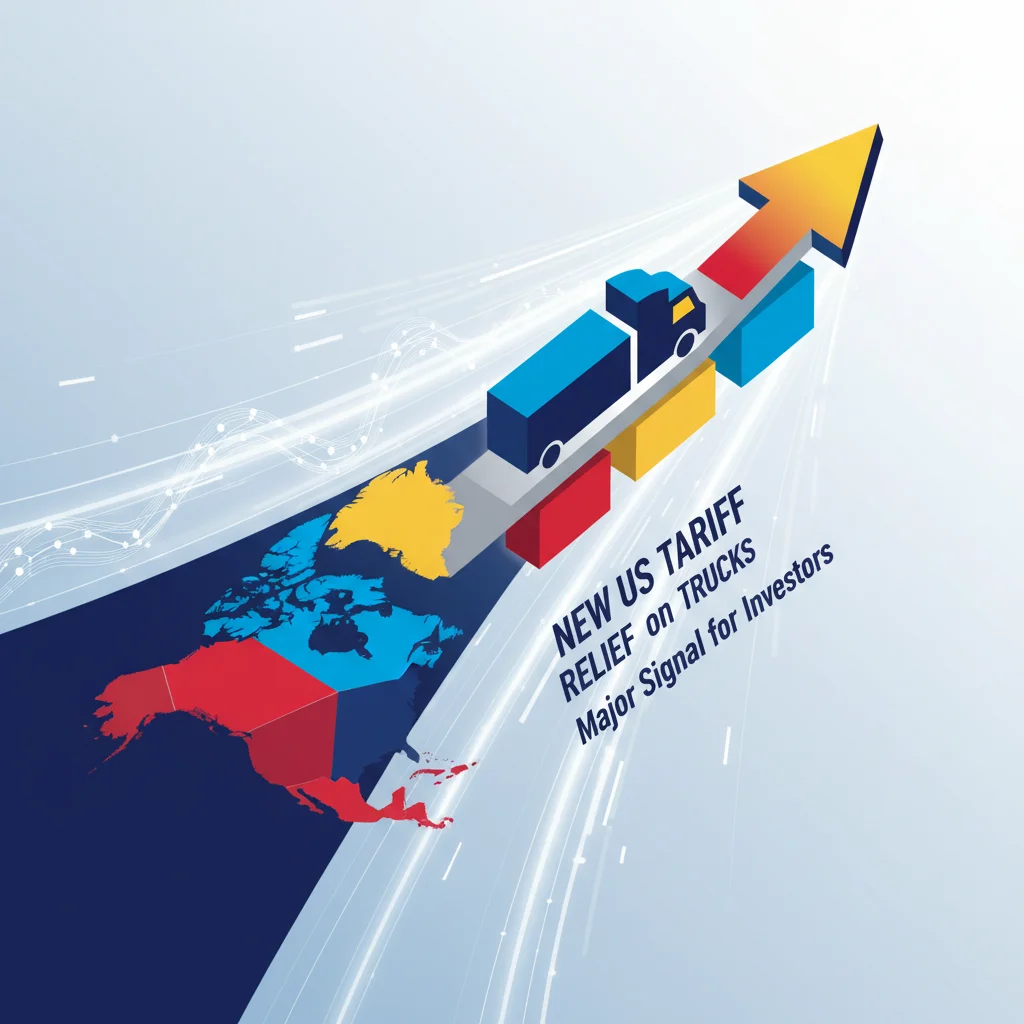
North American Trade Shift: Why New US Tariff Relief on Trucks is a Major Signal for Investors
In the intricate world of international trade and finance, even a seemingly minor policy adjustment can send significant ripples across the economy. Recently, the United States has quietly offered tariff relief for heavy trucks and their parts imported from Mexico and Canada. While this might sound like a niche industrial update, it’s a move deeply rooted in the framework of the United States-Mexico-Canada Agreement (USMCA) and serves as a powerful indicator of shifting geopolitical and economic priorities. For investors, business leaders, and anyone with an eye on the stock market, understanding the “why” behind this decision is crucial for navigating the future of North American commerce.
The core of the announcement is a series of “carve-outs” for heavy vehicles that are compliant with the stringent rules set forth in the 2020 trade pact, which replaced the decades-old NAFTA. According to the Financial Times, this relief is not a blanket giveaway but a targeted incentive designed to further entrench the highly integrated North American automotive supply chain. This policy is more than just a cost-saving measure for a few companies; it’s a strategic reinforcement of a continental economic bloc, with profound implications for manufacturing, logistics, and investment strategies.
From NAFTA’s Highway to USMCA’s Modern Road
To fully grasp the significance of this tariff relief, one must look back at the trade agreement that governs it. The USMCA, which came into force in July 2020, was a dramatic overhaul of the North American Free Trade Agreement (NAFTA). A key area of renegotiation was the automotive sector, with the new agreement imposing much stricter “Rules of Origin” requirements.
These rules dictate how much of a vehicle must be sourced from within North America to qualify for duty-free treatment. The goal was clear: to boost manufacturing and jobs within the three-country bloc and reduce reliance on parts from other regions, particularly Asia. This recent tariff relief is a direct consequence and enforcement mechanism of that vision.
Here’s a simplified breakdown of the key changes for the automotive sector under USMCA compared to NAFTA:
| Provision | NAFTA (Old Rules) | USMCA (New Rules) |
|---|---|---|
| Regional Value Content (RVC) | 62.5% of the vehicle’s net cost had to originate in North America. | Increased to 75%, a significant jump requiring more local sourcing. |
| Labor Value Content (LVC) | No specific labor wage requirement. | A new requirement: 40-45% of a vehicle’s content must be made by workers earning at least $16 USD per hour. (source) |
| Steel and Aluminum | No specific sourcing requirements for these metals. | Requires that 70% of a vehicle producer’s steel and aluminum purchases must originate in North America. |
This stringent framework makes compliance a complex and costly endeavor for manufacturers. Therefore, offering tariff relief specifically to those who meet these high standards acts as both a carrot and a stick, rewarding companies that align with the agreement’s goals and penalizing those that don’t.
The Trump Doctrine: Re-evaluating the "President of Peace" and His Impact on Global Markets
The Economic Ripple Effect: A Roadmap for Investors
For those involved in finance and investing, this policy shift is a critical data point that affects multiple sectors of the economy. It’s not just about truck manufacturers; it’s about the entire ecosystem that supports them.
1. Automotive and Manufacturing Sectors
The most immediate beneficiaries are heavy-duty truck manufacturers like Paccar, Daimler Truck, and Volvo Group, as well as the vast network of parts suppliers across the continent. Lower-cost, tariff-free access to components and assembly plants in Mexico and Canada streamlines production. This can lead to improved profit margins, increased capital for R&D, and potentially more competitive pricing. Investors should watch the earnings reports of these publicly traded companies for commentary on how this relief impacts their cost of goods sold and overall financial outlook.
2. Logistics and Transportation
The cost of a new heavy-duty truck is a major capital expenditure for logistics and shipping companies. Any policy that potentially lowers or stabilizes the price of these essential assets can improve the financial health of the transportation sector. This, in turn, can have a disinflationary effect, as lower shipping costs can trickle down to the prices of consumer goods. This is a crucial factor for the broader economy and a key consideration in macroeconomic analysis.
3. The Stock Market and Trading Strategies
This news reinforces the “near-shoring” or “friend-shoring” investment thesis. Companies that are reorienting their supply chains away from geopolitically sensitive regions and towards North America stand to benefit from policies like this. Investment analysts and trading desks will be modeling the long-term benefits for companies with significant manufacturing footprints in the US, Mexico, and Canada. This could make their stocks more attractive compared to competitors who are more exposed to overseas supply chain disruptions and tariffs.
The Convergence of Trade Policy and Financial Technology
The complexity of the USMCA’s Rules of Origin creates a significant administrative burden. How does a company prove that 75% of its truck components, by value, originated in North America? This is where modern financial technology (fintech) and other digital solutions are becoming indispensable.
The world of cross-border trade is no longer just about ships and trucks; it’s about data. The seamless flow of capital and information is what enables the physical flow of goods. Here’s how technology plays a role:
- Fintech and Trade Finance: Financial technology platforms are simplifying cross-border payments between, for example, a US truck assembler, a Mexican parts supplier, and a Canadian electronics provider. These platforms reduce friction and transaction costs, making the integrated supply chain more efficient. This is a critical function of the modern banking and finance ecosystem.
- Blockchain for Supply Chain Transparency: While still an emerging application, blockchain technology offers a powerful solution for compliance. An immutable ledger could be used to track every component from its source, providing regulators with an easily auditable and tamper-proof record. A company could use a blockchain to prove, for instance, that its steel was sourced from a North American mill, thus meeting the 70% requirement. This could dramatically reduce compliance costs and risks, making the tariff relief more accessible. (source)
- Data Analytics in Trading: Sophisticated investors and trading firms use advanced data analytics to model the impact of such policy changes. They scrape news, analyze trade data, and predict which companies will see the biggest margin improvements, using this information to inform their stock market strategies. Economics is increasingly a data science, and this is a prime example.
Ceasefire in Gaza: Analyzing the Economic Aftershocks and Investment Horizon
Navigating Potential Roadblocks and Headwinds
Despite the positive implications, the path forward is not without challenges. The benefits of this tariff relief are contingent on overcoming several hurdles.
- Compliance Complexity: The LVC and RVC rules are notoriously difficult to track and document. Smaller suppliers may lack the resources to provide the necessary certifications, potentially creating bottlenecks in the supply chain. The cost of compliance could, in some cases, outweigh the benefit of the tariff relief.
- Labor and Political Risks: The automotive sector is frequently at the center of labor negotiations and disputes. A major strike could paralyze the very supply chains this policy aims to support. Furthermore, with trade policy often being a political football, a future administration could potentially alter or reinterpret the USMCA’s enforcement, creating uncertainty for long-term investments.
- Broader Economic Conditions: Ultimately, the demand for heavy trucks is a reflection of the health of the overall economy. High interest rates, slowing consumer demand, or a recession could depress truck sales, rendering the tariff relief a moot point for a shrinking market.
Trade War 2.0? Unpacking the Global Economic Fallout of Trump's 100% China Tariff Threat
The Final Destination: A More Integrated North America
The US decision to offer targeted tariff relief on North American-made trucks is a microcosm of a much larger economic and geopolitical strategy. It is a deliberate, calculated move to strengthen the USMCA, encourage regional investment, and build a more resilient supply chain ecosystem insulated from overseas volatility.
For those in the world of finance, from individual investors to institutional leaders, the message is clear: the long-term trend is towards deeper North American integration. This policy creates clear winners in the automotive, manufacturing, and logistics sectors, but its effects will be felt across the stock market and the wider economy. By understanding the intricate connections between trade policy, industrial economics, and financial technology, stakeholders can better position themselves to capitalize on the road ahead.


